Easy Hikes in the Coast Range Oregon
11 Best Hikes on the Oregon Coast
The beautiful Oregon Coast is one long slice of paradise. Elevated headlands punctuate miles of sandy shoreline often dotted by stunning sea stacks. These eye-catching landscapes offer postcard views, one after the other. And unlike different coastlines in the U.S., thanks to the 1967 Oregon Beach Bill, Oregon's entire oceanfront is public property. This prominent public access opens a world of hiking opportunities.
It's always a good adventure whenever the ocean is in earshot. And alongside the surf's soundtrack, hiking trails on the Oregon Coast lead through coastal forests, down to secret beaches, and across solitary sand spits. Other adventurous landscapes include shifting dunes, and some trails follow the footsteps of Lewis and Clark.
Many of the best hiking trails are connected. The 362-mile Oregon Coast Trail spans the entire public oceanfront, paralleling much of the Oregon Coast Highway (Highway 101). This remarkable state-spanning trail navigates all the best hiking trails in one continuous route.
Find your own stretch of paradise with our list of the top hikes on the Oregon Coast.
Note: Some businesses may be temporarily closed due to recent global health and safety issues.
1. Fort to Sea Trail, Fort Clatsop
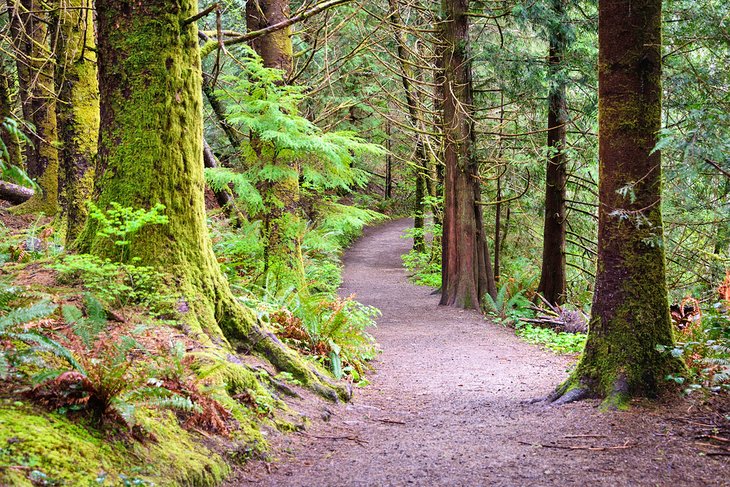
History and nature collide on the northern Oregon Coast at the Lewis and Clark National Historical Park. The park's centerpiece is the replica Fort Clatsop and adjoining visitor center, which is the site of the Corps of Discovery winter encampment between 1805 and 1806. Today, it's a popular area to learn about Lewis and Clark and the last few miles of their incredible journey.
The Fort to Sea Trail, leading from the Fort Clatsop Visitor Center, allows visitors to walk in the footsteps of the Corps of Discovery. It spans approximately 6.5 miles from the fort through forest, fields, and dunes to reach Sunset Beach. It's a wild environment and a long walk to make the one-way trek, but the changing coastal environment offers welcome distractions along the way.
A two-car shuttle eliminates the need for an out-and-back hike. Whatever direction, though, bring plenty of water because no potable water is available along the route. The trail includes steep inclines in either direction and sometimes muddy footpaths.
Other trails stem from Fort Clatsop for more accessible hikes, including the popular Clay Pit Pond Primitive Trail.
2. Tillamook Head Traverse Hike
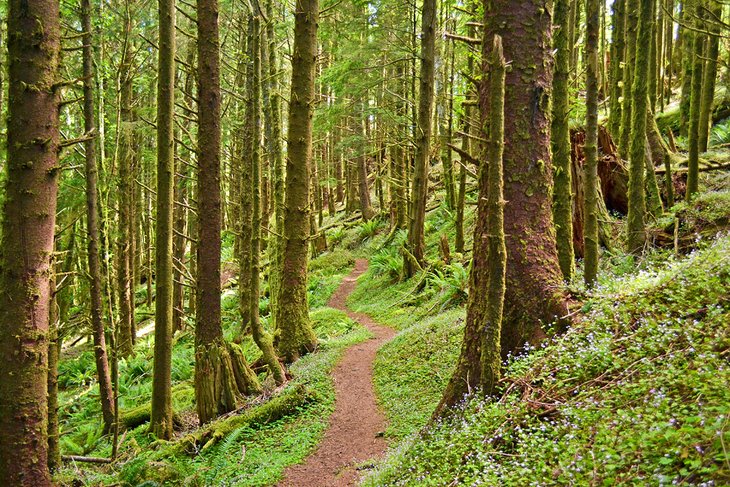
Tillamook Head is a defining headland separating Cannon Beach and Seaside on the northern coast. And the hike across this forested promontory is a must-do when visiting the region. It's also a historically significant route, once traversed by the Corps of Discovery and the many cultures that came before them.
The trail spans between the Tillamook Head Trailhead to the north and the Indian Beach Trailhead to the south. It's approximately a 6.3-mile hike between the two, with over 1,000 feet of elevation gain. Shuttles are available from Seaside to the Tillamook Head Trailhead.
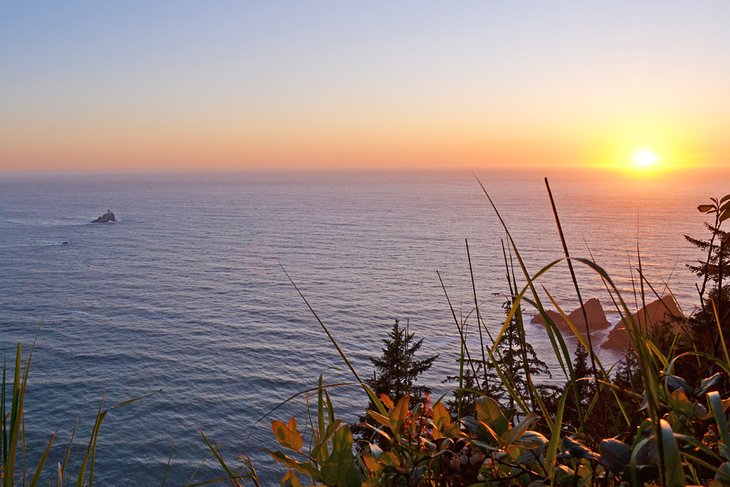
A highlight of the route, alongside the verdant scenery, is the beautiful viewpoint at the top of the head. Here, distant views of the retired Tillamook Rock Lighthouse encourage sunset visits, and a nearby backpacker's camp enables overnight expeditions.
3. Cape Perpetua Scenic Area
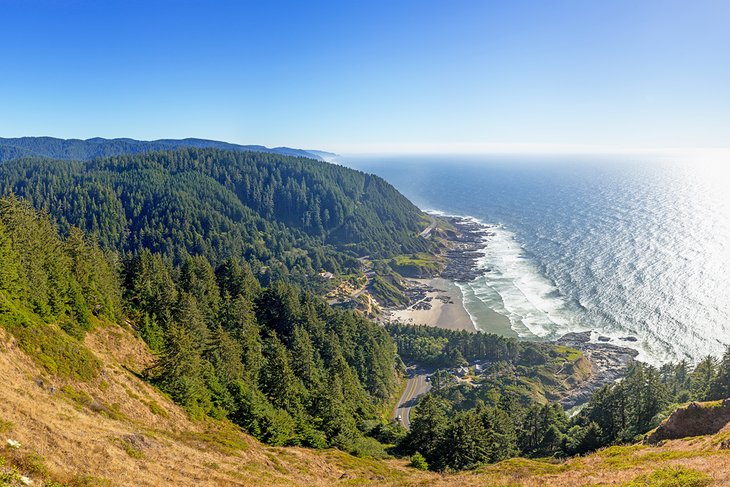
Cape Perpetua is two miles south of Yachats on the Central Oregon Coast, within the Siuslaw National Forest. It's one of the highest points accessible by car on the Oregon Coast, rising over 800 feet above the shoreline. However, while it's accessible via vehicle, the better way to experience Cape Perpetua is via its 26-mile network of trails.
A short 0.2-mile trail leads from the small parking area atop Cape Perpetua to the views. Alternatively, hikers can climb the 800-foot promontory from the north or south. These summit trails are a part of the state-spanning Oregon Coast Trail. The view atop Cape Perpetua is truly breathtaking, especially when opting for the uphill routes.
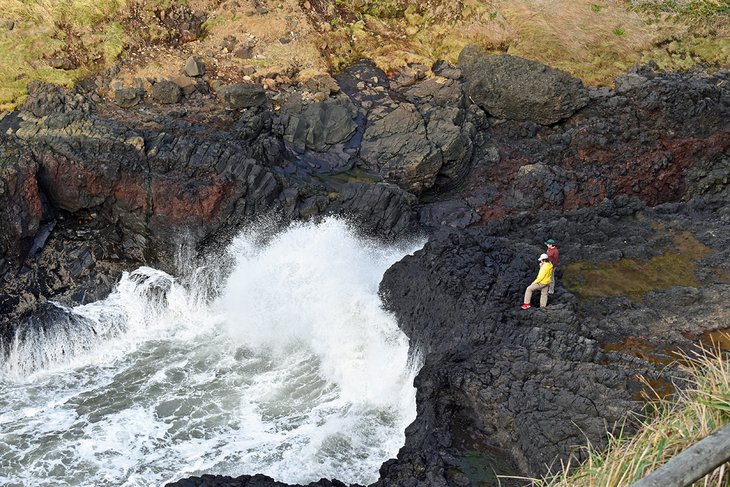
The Devil's Churn is another must-do hike when visiting Cape Perpetua. The trek starts from the Devil's Churn Info Center off the 101 and proceeds with a half-mile loop to the namesake feature. High tide is the best time to visit Devil's Churn, as the turbulent wake hits the jagged alcove to make a big splash.
4. Samuel H. Boardman State Scenic Corridor
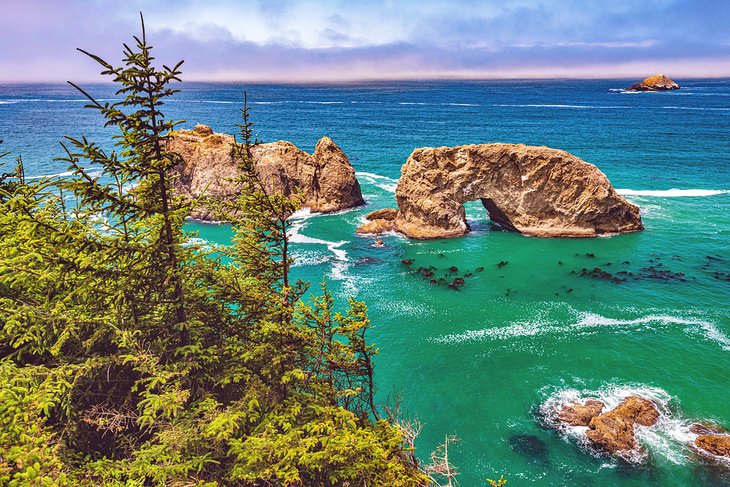
The Samuel H. Boardman State Scenic Corridor is a stunning 12-mile stretch on the Southern Oregon Coast. Rocky headlands, secret beaches, and adventurous hiking trails define this linear park, and several roadside trailheads and viewpoints line the entire expanse, offering days of exploration.
Signage can be hard to catch on this rugged section of the coast, and The Oregon Coast Trail connects nearly every route through the scenic corridor. A few recommended places to check out include Arch Rock, China Beach Trail, and Thomas Creek to Whaleshead Beach. However, half the fun can be pulling over wherever catches the eye.
Expect elevation change for any hike in the Samuel H. Boardman State Scenic Corridor. The roadway sits above the rugged coastline, and almost every hike begins with a steep route to the ocean. However, the views and feeling of wild exploration are well worth any uphill effort back to the car.
5. Netart's Spit - Cape Lookout State Park
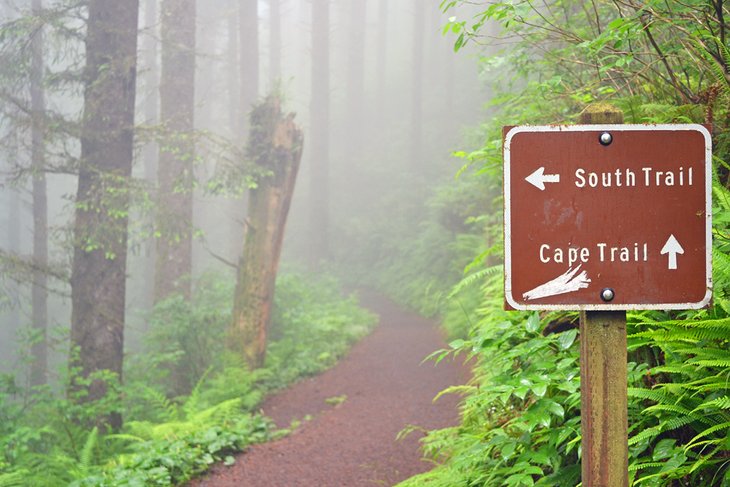
Approximately 80 miles west of Portland, Cape Lookout State Park is a signature destination on the coast. It's in the middle of the Three Capes Scenic Loop, one of the most scenic drives on this side of the country. The state park offers several recreation outlets, including a popular campground.
The 2.3-mile Cape Trail is one of the most popular routes in the park. This one-way route navigates a mossy coastal environment to reveal excellent views of the ocean. In addition, the Cape Trail is a great route to see migrating whales passing by the peninsula in the spring and fall.
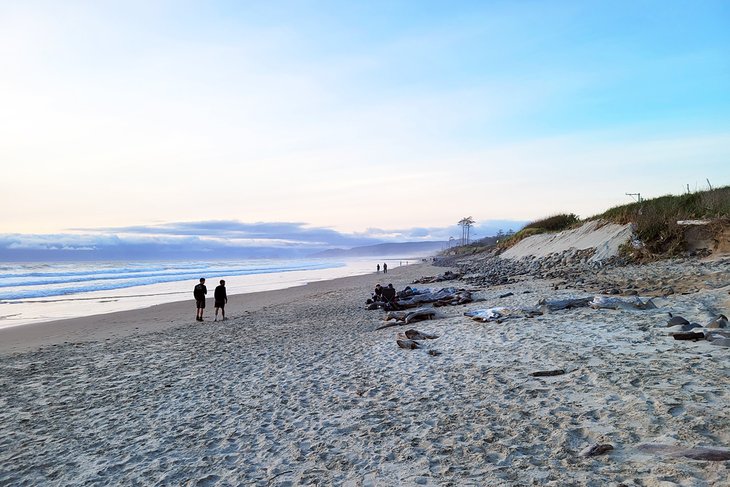
Another adventurous route at Cape Lookout is the Netart's Spit Trail. This long stretch of undeveloped sand extends north from the cape, and visitors are free to explore at their leisure. This sandy environment spans over five miles and offers moments of solitude watching the ocean waves. Trek as far as desired along this remote landscape, and experience a quieter connection to the coast.
6. Heceta Lighthouse Trail and Hobbit Trail
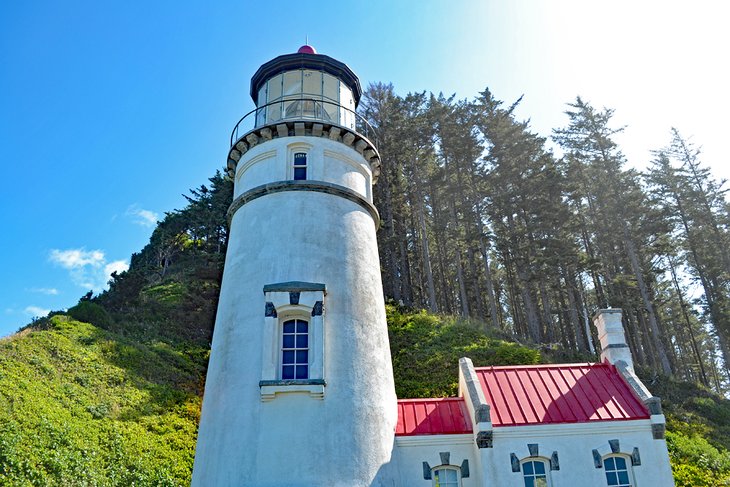
The 1,000-foot Heceta Head protrudes proudly as a significant attraction on the Central Oregon Coast. The historic lighthouse perched atop Heceta Head is one of the most photographed in the region, and the adjacent lighthouse keeper's home now operates as a charming bed and breakfast. This spectacular place to visit is approximately a 70-mile drive from Eugene.
It's an easy half-mile hike from the 101 to the top of Heceta Head from the parking area. There's slight elevation gain, but the path is wide and accommodating to most skill levels. For those making the trek during the summer, complimentary lighthouse tours are available between 11am and 3pm.
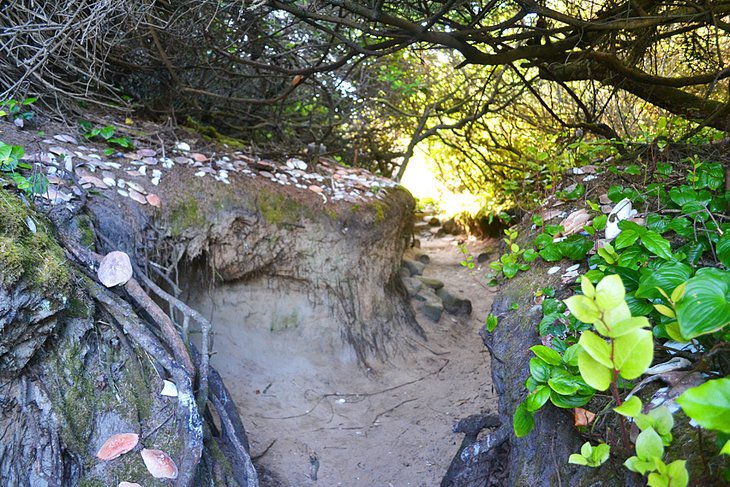
For a more adventurous trail from Heceta Head, the Heceta Lighthouse Trail continues down the opposite side of the head as part of the Oregon Coast Trail. This route descends quickly through a verdant forest known to host herds of Roosevelt elk. After a mile of trekking, the route connects to the trailhead for the Hobbit Trail. The Hobbit Trail navigates a magical forest for less than a mile before reaching the beach.
7. Cape Kiwanda
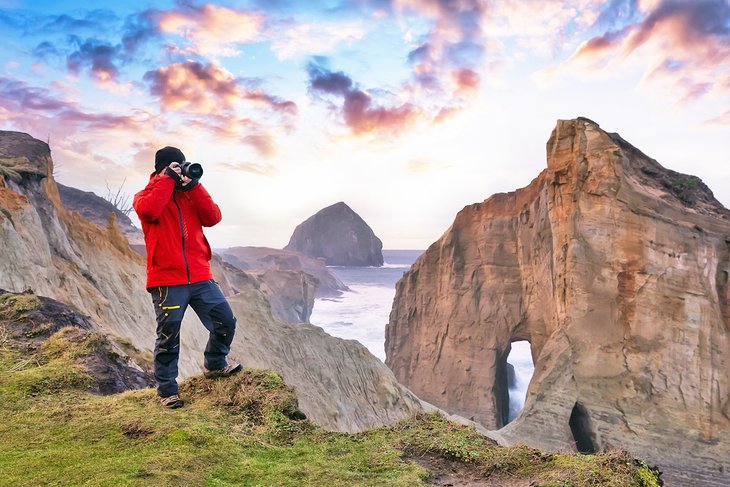
Cape Kiwanda, on the southern end of the Three Capes Scenic Loop, offers a unique hike with quite a view. Unlike the other two capes, Cape Kiwanda is made of sandstone and offers a shifting route to the top. Because of the dynamic terrain, there's no official hiking trail to summit Cape Kiwanda, but rather, other people's footsteps to follow.
The most common route to get to the top of Cape Kiwanda is from the neighboring Pacific City to the south. It's a short walk on the beach to Cape Kiwanda and up a sandy slope from there. The view atop Cape Kiwanda is spectacular, and the elevated landscape is a popular place for hang gliders to launch.
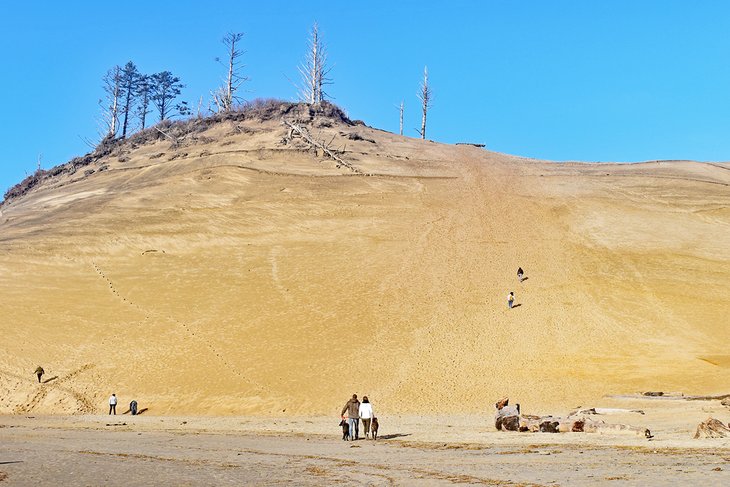
Take your time atop Cape Kiwanda, and watch the waves pound and shape the promontory. Be sure to remain behind the roped-off areas on the cape where the sandstone isn't stable for human exploration. Miles of untouched beaches surround both sides of Cape Kiwanda.
8. Neah-Kah-Nie Mountain Trail
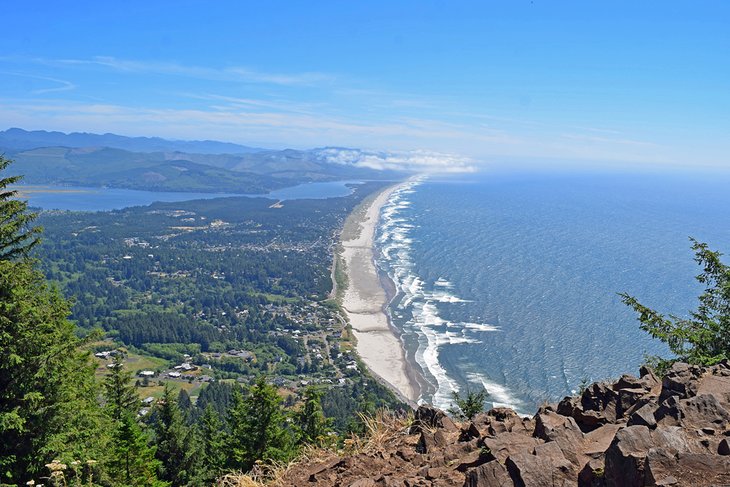
Neah-Kah-Nie Mountain, north of the charming town of Manzanita on the northern coast, is one of the highest points along the Oregon Coast Trail. It also provides a popular day hike that comes with quite a view. The mainstay of the mountain is within Oswald West State Park, which supports several other hiking trails worth checking out.
Before 2020, two routes led to the top of Neah-Kah-Nie Mountain: The North Neah-Kah-Nie Trail ascended approximately 1,100 feet in two miles from the 101 to reach the summit. The South Neah-Kah-Nie Trail starts on a gravel trail and offers a shorter route with less elevation gain. A 2020 blowdown significantly damaged the North Trail, however, leaving the 1.3-mile South Trail the only way up.
The views atop Neah-Kah-Nie Trail span for miles on clear days. The outlook includes Tillamook Head to the north and Cape Lookout to the south.
Neah-Kah-Nie Mountain isn't the only trail worth exploring in Oswald State Park. The Cape Falcon Trail and the Devil's Cauldron Overlook also offer memorable day trips.
9. God's Thumb via The Knoll
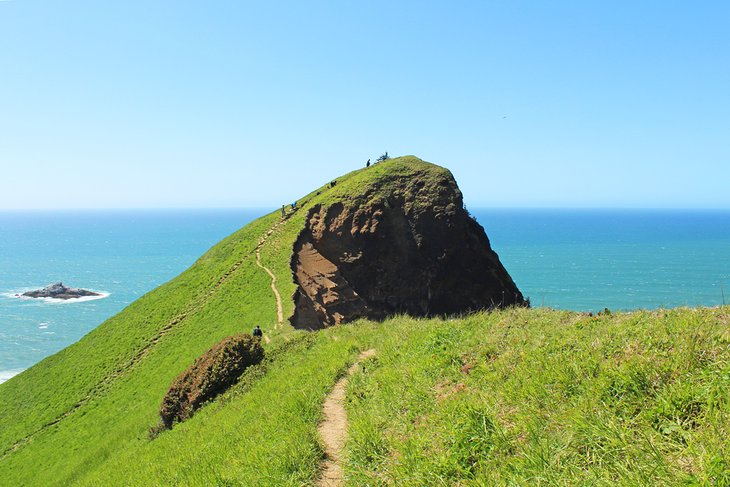
The Thumb Hike, also known as "God's Thumb," is a popular uphill route north of Lincoln City. The trail navigates through Siuslaw National Forest above neighborhoods before entering The Knoll Open Space. Here, the basalt formation known as the Thumb is easy to spot, and a well-defined trail leads to the top.
A few different trailheads lend access to God's Thumb and The Knoll. Like the Villages at Cascade Head Trailhead, many of these trailheads are at the end of residential streets. Typical round trips on the trail span anywhere between three and five miles with moderate elevation gain.
The Salmon River Estuary and Cascade Head are in plain view to the north from atop God's Thumb, as well as a commanding view of the ocean. Plan to spend some time hanging out at this windy spot to take some pictures. Keep an eye out for Roosevelt elk, too, as they are known to frequent the area.
10. John Dellenback Trail, Oregon Dunes National Recreation Area

The Oregon Dunes National Recreation Area encompasses one of the largest expanses of temperate coastal dunes in the world. The amount of sprawling sand throughout is simply stunning, and the landscape is constantly changing depending on which way the wind's blowing.
The dunes are a hot spot for off-road vehicles and all-terrain vehicles. Several staging areas line the approximately 40-mile stretch of the national recreation area between Florence and Coos Bay. Because of this, finding a spot to hike without the noise of revving motors can be challenging. But the John Dellenback Trail, part of the Umpqua Dunes Area, offers a quiet place to enjoy the sand.
The John Dellenback Trail, named after the U.S. Representative responsible for the National Recreation Area's creation, starts near the Eel Creek Campground and Highway 101. It quickly crosses from a conifer forest into a sprawling set of dunes.
The route spans nearly three miles before reaching the beach. The shifting landscape doesn't allow for permanent trail markers along the way. It's recommended to climb up the highest dune to gain some bearings upon starting the hike. Expect hot weather, no water, and slow-moving footsteps when navigating the sand.
11. Oregon Coast Trail
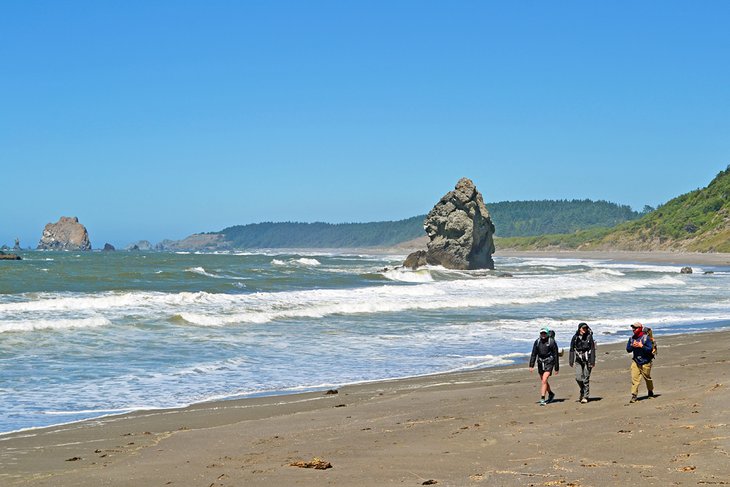
For those looking for an extended adventure, a state-spanning trail connects Oregon's entire coastline. One of the top hiking trails in Oregon, the Oregon Coast Trail spans 360-plus miles from Astoria to the north down to the California border. And while this might sound like a long beach walk, the route traverses several unique coastal landscapes, including 28 charming towns.
The route combines headland hiking trails, sandy shorelines, and the occasional road walk along Highway 101. As of 2021, approximately 10 percent of the path follows pavement. Other challenging landscapes along the way include shifting dunes and estuary crossings. High tide is also something to contend with, especially on sections where camping on the beach is allowed.
However, most of the camping on the Oregon Coast Trail takes place slightly inland, typically at a state park. Every state park along the coast has hiker/biker campsites reserved for non-motorized travelers. These sites have a place to pitch a tent, and community picnic benches. Reservations are not necessary at hiker/biker sites.
A complete thru-hike of the Oregon Coast Trail takes about four to six weeks. The trail is roughly divided into 10 sections, which can be tackled individually for those without a whole month to devote to hiking. Several online resources assist in logistics like campsites, re-supply locations, and gear lists.
Source: https://www.planetware.com/oregon/best-hikes-on-the-oregon-coast-us-or-108.htm
0 Response to "Easy Hikes in the Coast Range Oregon"
Publicar un comentario